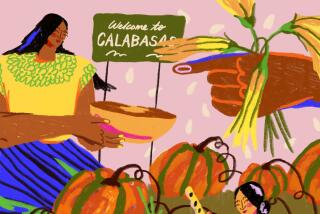Family Relations
- Share via
Squashes belong to the Cucurbita species and fall into four subspecies. Pumpkins do not belong to any of these; rather, they belong to all of them.
In fact, the word pumpkin has no real botanical significance. It came out of common usage, evolving from the Greek word pepon , which means “cooked” (by the sun). This beautiful idea is filled with the images of the brilliance and roundness of the sun itself as well as the flaming orange of the ripened flesh.
* Most pumpkins, from microminis to big-hearted jack-o’-lanterns, come from the pepo subspecies, including Baby Bear, Connecticut Field, Jack-Be-Little and Small Sugar. Pepos also give us Acorn, Delicata, Sweet Dumpling and Vegetable Spaghetti winter squashes.
* Maximas, generally the sweetest, least fibrous, best-keeping and largest winter squashes, give us most of the coach-size pumpkins, including Rouge Vif d’Etampes and Atlantic Giant. Good-tasting Lumina is also here, as well as Banana, Buttercup, Hubbard and Kabocha squashes.
* Moschatas have sweet, flavorful and often fragrant flesh. One of their number, the Cheeses--so called because they resemble wheels of cheese--are among the oldest squashes cultivated. Magdalena Big Cheese is one. Here, too, are the delicious butternuts, whose flavor improves on keeping.
* Mixtas are mostly bottle- and pear-shaped. Their flesh is not as refined as the flesh of other winter squashes, but they’re excellent keepers and prized where water is scarce. None has an orange shell, but a few, like Veracruz Pepita, are flattened rounds, grown for their cache of pumpkin seeds.
More to Read
Eat your way across L.A.
Get our weekly Tasting Notes newsletter for reviews, news and more.
You may occasionally receive promotional content from the Los Angeles Times.








